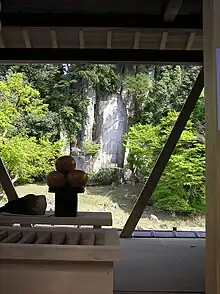Ōno-ji
Ōno-ji or Ōno-dera (大野寺) is a temple of the Shingon school of Buddhism, located in the city of Uda, Nara Prefecture, Japan.

The stone sculpture across the Uda River viewed from Ōno-ji, through a small prayers hall.
According to legend and myth, the temple was first opened by En no Gyōja in 681, rendered west entrance to Murō-ji by Kūkai in 824, then later became known with its current name.
Overview
Ōno-ji is best known for its 11.5 meter tall stone sculpture of bodhisattva Maitreya, carved across the Uda River (宇田川), to the north of the temple. The sculpture was ordered by abdicated Emperor Go-Toba, in response to monk Gaen (雅縁) of Kōfuku-ji. A mason from Song is believed to have done the sculpture between 1207 and 1209. Other treasures held by the temple include the wooden Jizō bodhisattva image (Important Cultural Property).
See also
- For an explanation of terms concerning Japanese Buddhism, Japanese Buddhist art, and Japanese Buddhist temple architecture, see the Glossary of Japanese Buddhism.
References
- Itō, Matsuo (2003). En no Gyōja (修験道の開祖 役行者 その足跡に迫る) (in Japanese). Bungeisha. pp. 87–88. ISBN 4-8355-6114-7.
- Bhattacharyya, Asoke Kumar (2004). Early and Buddhist stone sculpture of Japan. Abhinav Publications. p. 34. ISBN 81-7017-422-8.
This article is issued from Wikipedia. The text is licensed under Creative Commons - Attribution - Sharealike. Additional terms may apply for the media files.